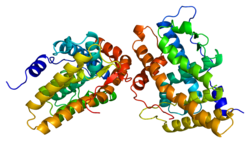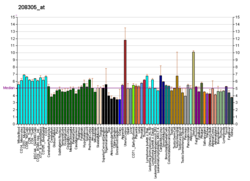
Back أروماتاز Arabic Aromataza BS Aromatasa Catalan CYP19A1 Welsh Aromatase Danish Aromatase German Aromatasa Spanish Aromatasa Basque آروماتاز Persian Aromataasi Finnish
Aromatase (EC 1.14.14.14), also called estrogen synthetase or estrogen synthase, is an enzyme responsible for a key step in the biosynthesis of estrogens. It is CYP19A1, a member of the cytochrome P450 superfamily, which are monooxygenases that catalyze many reactions involved in steroidogenesis. In particular, aromatase is responsible for the aromatization of androgens into estrogens. The enzyme aromatase can be found in many tissues including gonads (granulosa cells), brain, adipose tissue, placenta, blood vessels, skin, and bone, as well as in tissue of endometriosis, uterine fibroids, breast cancer, and endometrial cancer.[citation needed] It is an important factor in sexual development.
- ^ a b c GRCh38: Ensembl release 89: ENSG00000137869 – Ensembl, May 2017
- ^ a b c GRCm38: Ensembl release 89: ENSMUSG00000032274 – Ensembl, May 2017
- ^ "Human PubMed Reference:". National Center for Biotechnology Information, U.S. National Library of Medicine.
- ^ "Mouse PubMed Reference:". National Center for Biotechnology Information, U.S. National Library of Medicine.
© MMXXIII Rich X Search. We shall prevail. All rights reserved. Rich X Search





